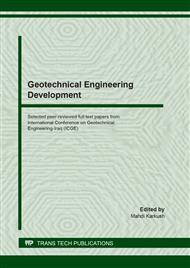p.188
p.195
p.203
p.212
p.221
p.228
p.234
p.243
p.253
Effect of Cavities from Gypsum Dissolution on Bearing Capacity of Soil under Square Footing
Abstract:
This study deals with cavities under square footing which resulted from gypsum dissolving due to water flow in gypseous soil. This process leads to collapse of soil structure and progressive compression. A model was developed for governing the mass-transport to assess the variation of gypsum content of the soil during dissolution by ground water flow then cavity formation was adopted. A general three-dimensional finite element program (PLAXIS 3D) was selected for numerical analysis method to generate the solution. The study included a number of variables and their effect on bearing capacity of gypseous soil such as (gypsum content, cavity volume and location). The cavity was represented as axis and plane cavity which has square section. The results show that the most dangerous case is found when the cavity locates at the center of footing base (Z/B = 0), where the bearing capacity decreased by (14, 37, and 69%) for (20, 30, and 40%) gypsum dissolving ratio respectively. Also, the bearing capacity decreased when the cavity volume increases due to increasing dissolution ratio. The effect of cavity became disappear after (Z/B = 4). While, when using plane cavity, there was no cavity at center of footing base (Z/B = 0) because it considered as a hole not cavity. When using plane cavity, the bearing capacity decreased by (28, 43, and 53%) for (20, 30, and 40%) dissolving ratio respectively when (Z/B=1). The effect of cavity on the bearing capacity would be disappear as the distance from footing center increase until it became disappear at (Z/B = 6 m). The plane cavity is more dangerous than axis cavity.
Info:
Periodical:
Pages:
221-227
Citation:
Online since:
August 2020
Authors:
Keywords:
Price:
Сopyright:
© 2020 Trans Tech Publications Ltd. All Rights Reserved
Share:
Citation:


